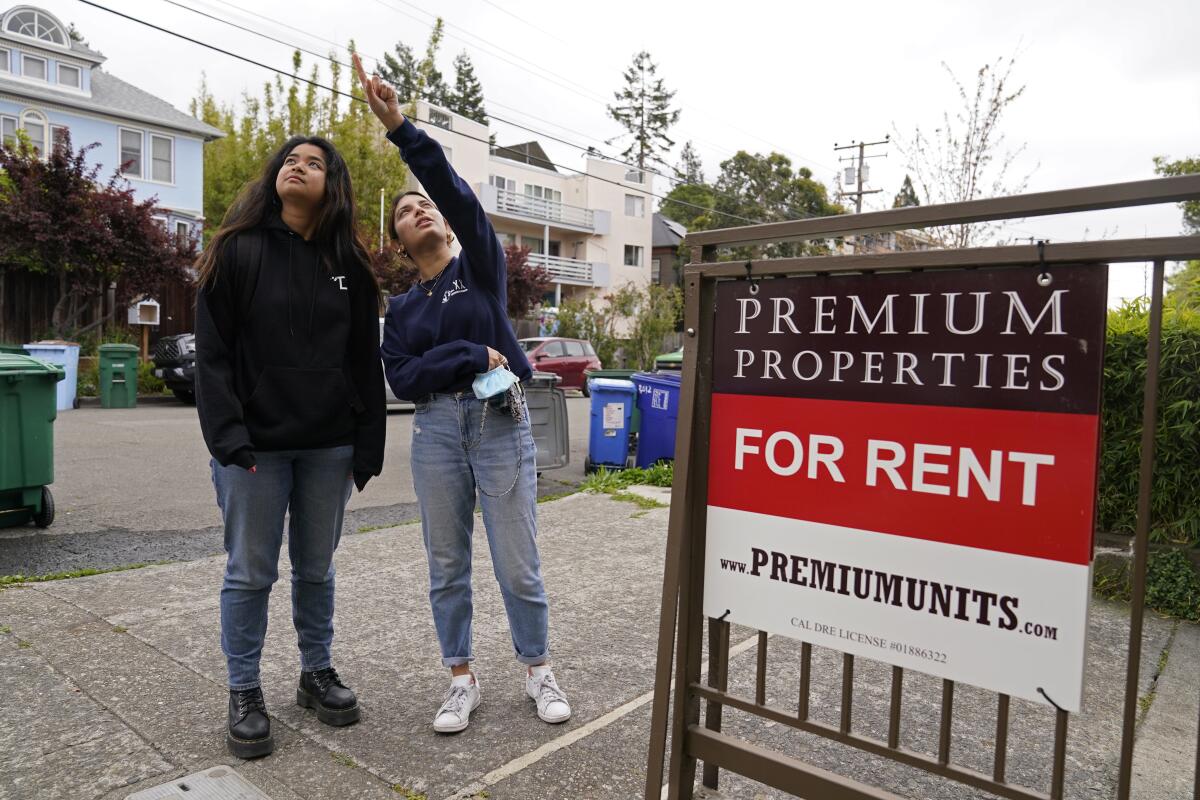Inflation improves slightly in April, but high cost of housing remains a big obstacle

WASHINGTON — Government data released Wednesday show that inflation eased a bit in April, but remains at a relatively high level. The latest report isn’t likely to lift the grim mood that much of the public has toward an otherwise solid economy.
Though incomes have generally risen more than consumer prices, the overall rate of inflation remains stubbornly high. It dropped a notch in April but was up 3.4% from a year ago, the Bureau of Labor Statistics said.
And unexpectedly, the biggest culprit is housing.
The Federal Reserve’s textbook-perfect policy of fighting inflation by pushing up interest rates has worked in large parts of the economy. The higher interest rates have helped slow growth in consumer prices for items such as food, gas, clothes and cars. Today, the inflation rate for those products is back down to, or even below, the central bank’s 2% target.
But the Fed’s same policy has paralyzed housing, an important segment of the economy, and sabotaged efforts to bring down overall inflation faster.
What the higher interest rates have done is freeze both homeowners and renters in place, discouraging either group from moving. The effect has been strong in California, where housing — what economists call the cost of “shelter” — was already very expensive.
And, in a complicated chain of cause and effect, the fact that both homeowners and renters are staying put has worked to keep inflation high.
“For two years we’ve been waiting for shelter inflation to drop enough to have an effect on the overall inflation rate. It’s constantly disappointing,” said G.U. Krueger, a longtime housing economist in Los Angeles.
“Because of high interest rates,” he said, “there’s no mobility out of rental situations to buy homes. Everyone is stuck — homeowners with golden handcuffs, renters basically with unadorned handcuffs.”
For homeowners, inflation is helping make their homes more valuable. But selling isn’t an option for many because they don’t want to give up their lower mortgage rates. Today the average 30-year fixed rate is more than 7%. Higher home prices also mean they could lose whatever gains they’d made when they replaced the house they’d sold.
For renters, there isn’t even the appearance of gains: They’re frozen in place because rent prices have failed to come down even though many new rental properties have come on the market. The typical rent for apartments and houses combined last month was about $2,920 in Los Angeles, making it one of the least affordable regions in the country, according to Zillow.
With more renters forced to stay put, there’s greater demand for, and lower vacancy at, many rental properties. That’s tended to keep pressure on prices even as more supply has come on line. Builders and landlords also are pricing rents to recoup higher costs for construction and maintenance.
Last month, consumer spending for shelter accounted for about 36% of the basket of goods and services that made up the government’s consumer price index, or CPI.
Fed policymakers track a different inflation measure in which housing isn’t given as much weight in figuring overall inflation. But both tell the same story: Housing inflation is running a lot hotter than for most other consumer goods and services.
In April, consumer prices overall rose 0.3% from March, seasonally adjusted, to an annual inflation rate of 3.4% compared with 3.5% the previous month. While that’s a dramatic decline from a 40-year high of 9.1% in June 2022, the improvement has been slowed by sticky inflation in housing.
Shelter prices in April also nudged down a bit over the month, but they were up 5.5% from a year ago, compared with 2.2% for all other goods and services combined, according to data from the Bureau of Labor Statistics.
Earlier this year, economists were expecting that a bigger decline in overall inflation would prompt the Fed to begin the first of a series of interest rate cuts this spring. But now, with prices for housing and some other services remaining high, many analysts aren’t so sure.
“I just don’t see a catalyst for any kind of rate cut right now,” said Jack Ablin, chief investment officer at Cresset, an asset management and advisory firm. “Maybe if we’re lucky we get one cut this year.”
The Fed’s benchmark interest rate, which influences borrowing rates on homes, cars and credit cards, is at a 23-year high of about 5.3%. Higher interest rates have been felt especially hard in California’s economy, given the importance of interest-sensitive sectors such as high-tech, entertainment and real estate.
One result is that job growth in the state has lagged behind; California’s latest unemployment rate, 5.3% in March, is the highest in the land. The state’s employment report for April comes out Friday.
Experts had been more optimistic about inflation falling faster after seeing signs of declining rents last year. But average rents have begun creeping higher again in recent months, thanks in part to bigger increases for rental houses.
U.S. rents for all housing rose on average 0.6% in April from March, and now stand at a whisker below $2,000 per month, according to Zillow. That’s up 31% since the start of the COVID-19 pandemic.
In high-priced markets such as California, steep home prices and high mortgage rates have made homeownership more elusive and soured people’s mood about the economy, with much of the blame falling on President Biden. Surveys indicate renters are among the least happy in the state and that many are considering moving out of Los Angeles.
Chris Salviati, housing economist at Apartment List, which tracks new leasing activity, said rents have come down significantly from double-digit levels but not fast enough. “It’s still moving in the right direction, but it’s a gradual decline. Certainly it’s been frustrating for folks.”
Why is housing inflation so sticky?
One factor is that most people sign yearlong leases, so there’s a lag and it takes time for changes in rents to show up. When home prices plummeted during the Great Recession, it took about 18 months for the shelter component in the CPI to moderate, said Chris Rupkey, chief economist at Fwdbonds, a financial research firm.
CPI figures on shelter also tend to understate what many consumers are experiencing. The data show that rents for primary residences in Los Angeles and Orange counties rose 4.4% in 2022, even though prices for all other goods and services combined jumped 9.3% that year. Since then, the trend has reversed: inflation for rents and shelter have been growing much faster than for all other items.
Experts say the recent upturn in rents may be due partly to apartment owners trying to recoup their higher costs, as the broader inflationary climate has meant they’re paying more for maintenance, supplies and labor.
“Landlords are trying to catch up,” said Erica Groshen, an economist affiliated with Cornell University and former commissioner of the U.S. Bureau of Labor Statistics, which publishes the CPI reports.
Some experts say that one possible answer to housing inflation is for the Fed to cut rates. While it may seem counterintuitive for policymakers to take such action when the economy and job market are still strong, lowering interest rates could spur mobility and also make it easier for builders to start more projects and thus boost supply.
But boosting demand for home purchases could also add more juice to home prices, at least in the short term, increasing risks of creating housing bubbles.
“For the Fed,” said Rupkey, “it’s damned if you do, and damned if you don’t.”
More to Read
Inside the business of entertainment
The Wide Shot brings you news, analysis and insights on everything from streaming wars to production — and what it all means for the future.
You may occasionally receive promotional content from the Los Angeles Times.











